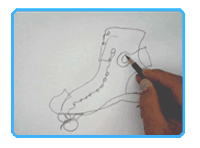
By Matt Fussell
Creating a blind contour line drawing is a great drawing exercise. It is a classic for art instructors everywhere, yet many art instructors miss the point. Often, I ask my students if they've created a blind contour line drawing and most answer that they have. When I ask them the purpose of the exercise, the students are clueless. Blind contour line drawing has several benefits.
First, it improves hand-eye coordination. Hand-eye coordination is important in drawing for obvious reasons. Secondly, blind contour line drawing forces you to look at the object that you are drawing. Perhaps most importantly, it helps the artist to understand that representational drawing is all about observation. Without keen observation skills, the representational artist is lost. Remember, the first secret to drawing is that drawing is at least 50% observation.
Continuous blind contour line drawing has two rules. First, once your pencil is placed on the surface, you may not lift it again. Secondly, you may not look at the paper. In other words, you must try to move your pencil at the same speed as your eyes move over the surface of the contour lines of the object.
Blind Contour line drawing is a drawing exercise that can done almost anywhere. It can actually lead to finished drawings as well.
(Video transcription further down this page)
Video Transcription
Today we're going to take a look at doing Blind Contour Line drawings. Basically what I'm going to try and do is try to move my eye at the same speed that I'm going to move my pencil as I'm looking at this object. I'm only going to draw the contour lines. I'm going to be drawing this roller skate here. There are really only two rules when creating a blind contour line drawing. First, if you want the line to be continuous, once you put your pencil down on the surface of the paper, you cannot pick it up again. The second rule is that you cannot look at your paper. So you need to be looking at your object 100% of the time. And like I said, I'm trying to move my pencil at the same speed that I am moving my eyes across the contours of the object. The contours are the outlines of the object. Now, doing this exercise will help you in a couple of ways. First, it will enhance your hand-eye coordination. And everyone knows that hand-eye coordination is important to drawing because you are looking at the objects and you are interpreting that information in your mind. And then you are controlling your hands to transfer that information. So, hand-eye coordination is important. The second thing it is doing is that it is forcing you to look at the object. You're having to really look at it because you can't look at your paper at all. Which leads you to the first secret to drawing. Now, there are three secrets to drawing, in my opinion. The first secret to drawing is that drawing is at least 50% observation. You have to look at an object in order to draw it accurately. You can't take a photograph of an object without pointing the camera at the object. It would seem absurd, right? To say that you could take a picture or a photograph of an object without pointing a camera at it. Yet so many artists try to draw things without looking at them. Okay, so blind contour line drawings will help you get in the right mood for drawing. It will help you learn to observe. This has been another video tutorial brought to you by TheVirtualInstructor.com.
Here are some more art lessons that you may like...